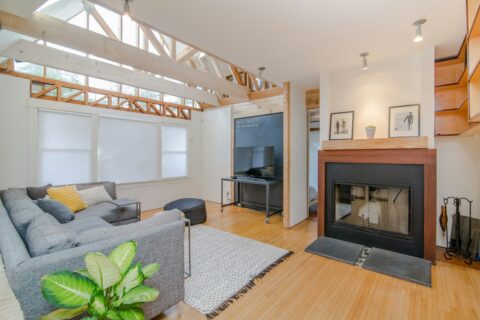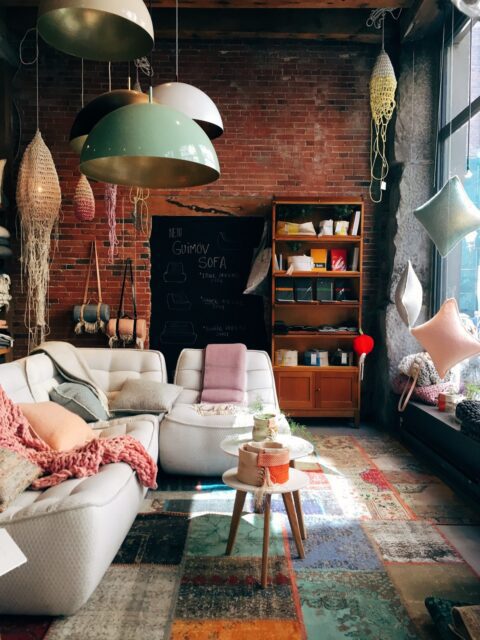Introduction to the trend of incorporating plants in home décor
Bringing Nature Indoors: The Beauty and Benefits of Incorporating Plants in Your Home Décor
Welcome to a world where lush greenery, vibrant blooms, and fresh air thrive right within the comfort of your own home. It’s time to embrace the growing trend of incorporating plants into your interior design – a trend that not only adds an undeniable aesthetic appeal but also brings numerous physical and mental health benefits.
From reducing stress levels to improving air quality, indoor plants have become much more than mere decorative accessories. They have become essential elements in creating tranquil and rejuvenating spaces that enhance our overall well-being. So, if you’re ready to infuse nature into every nook and cranny of your living space, let’s dive into the wonderful world of indoor gardening!
The physical and mental health benefits of having plants in your home
Having plants in your home is not just about adding a touch of greenery to your décor – it also offers numerous physical and mental health benefits. Studies have shown that being around plants can reduce stress levels, boost mood, and improve overall well-being.
One of the main benefits of indoor plants is their ability to purify the air by removing toxins and releasing oxygen. This can help create a healthier environment for you and your family, especially if you live in an urban area with poor air quality.
Additionally, having plants in your home can promote relaxation and calmness. The presence of nature indoors has been linked to reduced anxiety levels and increased feelings of tranquility. It’s like bringing a piece of the outdoors inside, creating a soothing sanctuary within your own four walls.
Furthermore, caring for indoor plants can be therapeutic in itself. Engaging with nature has been proven to decrease cortisol levels (the hormone associated with stress) while increasing serotonin (the “feel-good” hormone). So tending to your plant babies not only beautifies your space but also uplifts your spirits.
Incorporating plants into our homes is more than just an aesthetic choice – it’s an investment in our well-being. By embracing this trend, we can enjoy improved air quality, reduced stress levels, enhanced mood, and a sense of inner peace – all by simply surrounding ourselves with the beauty of nature indoors!
Types of indoor plants and how to care for them
Types of indoor plants and how to care for them
Indoor plants are not only visually appealing but also have numerous health benefits. When it comes to choosing the right indoor plant for your home, there are a plethora of options available. Each plant has its own unique care requirements and characteristics that make them suitable for different environments.
One popular choice is the Snake Plant (Sansevieria). It is known for its ability to purify the air by removing toxins such as formaldehyde and benzene. Snake Plants thrive in medium to bright indirect light and only need watering every 2-6 weeks, making them perfect for busy individuals or those with less green thumb experience.
Another great option is the Peace Lily (Spathiphyllum), which not only adds beauty but also helps improve air quality by removing harmful volatile organic compounds (VOCs) from the surroundings. They prefer low to medium light conditions and require regular watering, ensuring that their soil remains moist.
For those seeking a touch of tropical flair, consider adding a Parlor Palm (Chamaedorea elegans) or a Bird’s Nest Fern (Asplenium nidus) to your indoor garden collection. These plants flourish in moderate indirect light conditions and require consistent moisture levels in their soil.
If you’re looking for an easy-care option that can withstand neglectful tendencies, go with the ZZ Plant (Zamioculcas zamiifolia). This resilient plant thrives in low-light areas and requires minimal watering due to its drought-tolerant nature.
No matter which type of indoor plant you choose, it’s important to assess factors like lighting conditions, humidity levels, temperature range, and water requirements specific to each species. By understanding these needs and providing appropriate care accordingly, you can enjoy lush greenery indoors without much hassle!
Remember that incorporating plants into your home decor not only enhances aesthetics but also promotes better air quality while reducing stress levels. So, take the time to select the perfect indoor plants for your living space and start
Creative ways to incorporate plants in different rooms of your home
Creative Ways to Incorporate Plants in Different Rooms of Your Home
Living Room:
Incorporating plants into your living room can instantly bring life and vibrancy to the space. Place a large potted plant in a corner or create a botanical gallery wall using framed prints of different plant species. For smaller spaces, consider hanging plants from the ceiling or placing them on floating shelves.
Kitchen:
The kitchen is not just for cooking; it can also be an ideal spot for indoor gardening. Utilize windowsills to grow herbs like basil, mint, and rosemary. Hang small pots with trailing plants above the sink or place succulents on open shelving for a touch of greenery.
Bedroom:
Transform your bedroom into a peaceful oasis by adding plants that promote relaxation and better sleep. Aloe vera and lavender are great choices due to their calming properties. Create visual interest by grouping different-sized plants together on bedside tables or placing them on window ledges.
Bathroom:
Bring spa-like vibes into your bathroom by incorporating humidity-loving plants such as ferns, orchids, or spider plants. Hang macrame plant holders from hooks near windows or use stylish plant stands to elevate greenery off the floor.
Home Office:
Boost productivity and creativity in your home office with the help of houseplants. Choose air-purifying varieties like peace lilies or snake plants that can improve indoor air quality by removing toxins. Position desk-friendly plants like succulents or cacti within easy reach for added inspiration during long work hours.
Children’s Room:
Introduce children to the wonders of nature by integrating child-friendly plants into their rooms. Opt for low-maintenance options such as spiderettes (baby spiders) placed in glass jars filled with water, creating an educational display piece they’ll love watching grow.
Outdoor Spaces (Balcony/Patio):
Don’t limit yourself to indoor spaces – extend your green thumb outdoors too! Utilize balcony or patio areas by placing potted plants and herbs on shelves, hanging
Tips for those with limited space or a black thumb
Limited space or a black thumb should not deter you from bringing nature indoors. There are still options for incorporating plants into your home décor, even if you have limited space or struggle to keep plants alive.
One option for those with limited space is to choose small and compact plants that can thrive in smaller pots. Succulents and cacti are great choices as they require minimal care and can survive in dry conditions. They also come in various shapes and sizes, allowing you to create interesting arrangements on shelves or windowsills.
If you lack natural light, consider investing in low-light tolerant plants such as snake plants or ZZ plants. These varieties can thrive even in dimly lit rooms, making them perfect for apartments with limited sunlight exposure.
For those who struggle with keeping plants alive, opt for hardy species that are forgiving of neglect. Spider plants and pothos are known to be resilient and can tolerate inconsistent watering schedules. Additionally, using self-watering planters or incorporating a drip irrigation system can help alleviate the stress of remembering to water your green friends regularly.
To maximize limited space, utilize vertical gardening techniques by hanging planters or installing wall-mounted shelves specifically designed for displaying potted plants. This allows you to add greenery without taking up precious floor space.
Don’t forget about artificial plants! While they may not provide the same air-purifying benefits as live ones do, they still offer aesthetic appeal without requiring any maintenance whatsoever.
Incorporating nature into your home doesn’t have to be complicated or daunting, regardless of the size of your living area or your ability to keep traditional houseplants thriving. With these tips tailored specifically for those with limited space or a black thumb, anyone can enjoy the beauty and benefits of indoor gardening!
Sustainable and eco-friendly aspects of indoor gardening
Sustainable and eco-friendly aspects of indoor gardening
When it comes to incorporating plants into your home décor, not only are you adding beauty and freshness to your space, but you are also contributing to a more sustainable and eco-friendly lifestyle. Indoor gardening allows us to create our own little green oasis while reducing our carbon footprint.
One of the most significant benefits of indoor plants is their ability to purify the air we breathe. Plants absorb carbon dioxide and release oxygen through photosynthesis, improving the overall air quality in our homes. By having a variety of plant species indoors, we can effectively filter out harmful toxins such as formaldehyde and benzene that are commonly found in household products.
Furthermore, growing your own herbs or vegetables indoors reduces the need for store-bought produce that often comes with excessive packaging and transportation emissions. You can easily cultivate an herb garden on your windowsill or grow leafy greens in vertical planters, ensuring a fresh supply of organic food right at your fingertips.
Indoor gardening is also water-efficient compared to traditional outdoor gardening methods. With proper watering techniques like using self-watering pots or collecting rainwater for irrigation purposes, you can minimize water waste significantly.
Additionally, by opting for organic fertilizers instead of chemical-based ones, you promote a healthier ecosystem within your home while avoiding harm to beneficial insects such as bees and butterflies.
Incorporating sustainable practices into indoor gardening extends beyond just choosing environmentally friendly materials; it involves adopting principles such as reusing containers for propagation or upcycling old furniture into stylish plant stands.
Embracing indoor gardening not only enhances our living spaces but also promotes sustainability by reducing pollution from transportation, conserving water resources, promoting biodiversity within our homes,
and minimizing waste produced from conventional farming practices. So why not join this green revolution today?
Conclusion: How adding plants to your home can enhance your overall well-being and living space
Adding plants to your home can do wonders for your overall well-being and living space. Not only do they bring a touch of nature indoors, but they also offer numerous physical and mental health benefits.
By incorporating plants in your home décor, you can create a serene and calming environment that promotes relaxation and reduces stress. Studies have shown that being around plants can lower blood pressure, improve mood, and increase productivity. The greenery adds life to any room, making it feel more vibrant and inviting.
There are many types of indoor plants to choose from, each with its own unique beauty and care requirements. From low-maintenance succulents to lush tropical ferns, there is a plant suitable for every skill level and space availability. With proper care such as watering regularly and providing adequate sunlight or shade depending on the plant’s needs, you can enjoy their beauty for years to come.
Incorporating plants creatively into different rooms of your home allows you to embrace their aesthetic appeal fully. Hanging baskets in the kitchen add a fresh pop of color while purifying the air naturally. Placing potted palms or tall ficus trees in the living room creates an instant focal point while bringing a sense of tranquility. Even bathrooms can benefit from small potted herbs or spider plants on shelves or countertops.
For those with limited space or lacking a green thumb, there are still options available! Vertical gardens using wall-mounted planters or hanging shelves maximize space utilization while adding visual interest. Air plants require no soil at all – simply mist them occasionally for moisture! And if keeping real plants alive seems daunting? High-quality artificial foliage has come a long way in mimicking the real thing without any maintenance required.
Embracing indoor gardening also aligns with sustainable living practices by reducing carbon emissions associated with transporting cut flowers over long distances. By growing your own herbs or vegetables indoors, you not only save money but also reduce waste since you harvest only what you need. Additionally, plants contribute to cleaner air by absorbing toxins and releasing







